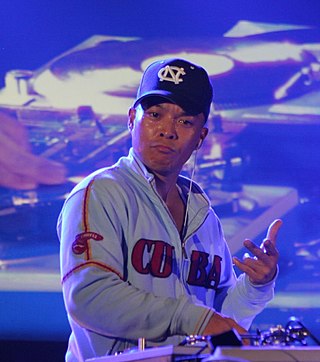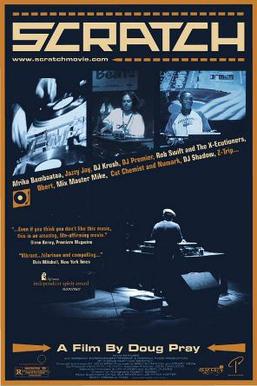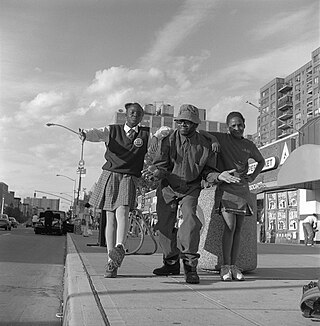
A disc jockey, more commonly abbreviated as DJ, is a person who plays recorded music for an audience. Types of DJs include radio DJs, club DJs, mobile DJs, and turntablists. Originally, the "disc" in "disc jockey" referred to shellac and later vinyl records, but nowadays DJ is used as an all-encompassing term to also describe persons who mix music from other recording media such as cassettes, CDs or digital audio files on a CDJ, controller, or even a laptop. DJs may adopt the title "DJ" in front of their real names, adopted pseudonyms, or stage names.

Scratching, sometimes referred to as scrubbing, is a DJ and turntablist technique of moving a vinyl record back and forth on a turntable to produce percussive or rhythmic sounds. A crossfader on a DJ mixer may be used to fade between two records simultaneously.
A battle record, also often called a battle tool or battle breaks, is a vinyl record made up of brief samples from songs, film dialogue, sound effects, and drum loops for use by a DJ. The samples and drum loops are used for scratching and performances by turntablists. The most famous example of this format is Super Duck Breaks, a 1996 release by "The Turntablist," a pseudonym of DJ Babu.

Turntablism is the art of manipulating sounds and creating new music, sound effects, mixes and other creative sounds and beats, typically by using two or more turntables and a cross fader-equipped DJ mixer. The mixer is plugged into a PA system and/or broadcasting equipment so that a wider audience can hear the turntablist's music. Turntablists typically manipulate records on a turntable by moving the record with their hand to cue the stylus to exact points on a record, and by touching or moving the platter or record to stop, slow down, speed up or, spin the record backwards, or moving the turntable platter back and forth, all while using a DJ mixer's crossfader control and the mixer's gain and equalization controls to adjust the sound and level of each turntable. Turntablists typically use two or more turntables and headphones to cue up desired start points on different records.

Beatboxing is a form of vocal percussion primarily involving the art of mimicking drum machines, using one's mouth, lips, tongue, and voice. It may also involve vocal imitation of turntablism, and other musical instruments. Beatboxing today is connected with hip-hop culture, often referred to as "the fifth element" of hip-hop, although it is not limited to hip-hop music. The term "beatboxing" is sometimes used to refer to vocal percussion in general.

Scratch is a 2001 documentary film, directed and edited by Doug Pray. The film explores the world of the hip-hop DJ from the birth of hip-hop when pioneering DJs began extending breaks on records, to the invention of scratching and beat juggling, to the more recent explosion of turntablism. Throughout the documentary, many artists explain how they were introduced to hip-hop while providing stories of their personal experiences.
The Invisibl Skratch Piklz are an American group of turntablists.

Derek Showard, better known by the stage name GrandMixer DXT, is an American musician, and the first DJ to use the turntable as a musical instrument.

A DJ mixer is a type of audio mixing console used by disc jockeys (DJs) to control and manipulate multiple audio signals. Some DJs use the mixer to make seamless transitions from one song to another when they are playing records at a dance club. Hip hop DJs and turntablists use the DJ mixer to play record players like a musical instrument and create new sounds. DJs in the disco, house music, electronic dance music and other dance-oriented genres use the mixer to make smooth transitions between different sound recordings as they are playing. The sources are typically record turntables, compact cassettes, CDJs, or DJ software on a laptop. DJ mixers allow the DJ to use headphones to preview the next song before playing it to the audience. Most low- to mid-priced DJ mixers can only accommodate two turntables or CD players, but some mixers can accommodate up to six turntables or CD players. DJs and turntablists in hip hop music and nu metal use DJ mixers to create beats, loops and so-called scratching sound effects.

Hip hop production is the creation of hip hop music in a recording studio. While the term encompasses all aspects of hip hop music creation, including recording the rapping of an MC, a turntablist or DJ providing a beat, playing samples and "scratching" using record players and the creation of a rhythmic backing track, using a drum machine or sequencer, it is most commonly used to refer to recording the instrumental, non-lyrical and non-vocal aspects of hip hop.

Rob Swift is an American hip hop DJ and turntablist. He was an original member of the turntablist group The X-Ecutioners until 2004. Over his career, he has released numerous solo albums and collaborated with various artists, including Mike Patton, Patton's project Peeping Tom, Dan the Automator and Handsome Boy Modeling School, Lords of Acid, Portugal. The Man, and Herbie Hancock.
DJ Disk is a turntablist from the San Francisco Bay Area. He is of Panamanian, Colombian, and Nicaraguan descent. Born Luis Quintanilla on October 7, 1970, in San Francisco, Disk began scratching and mixing vinyl at a young age. In 1992, he joined his long-time friend DJ Qbert among the Rock Steady Crew DJs, later changing the group's name to the Invisibl Skratch Piklz.
DJ Woody is a prolific DJ and turntablist born in Burnley, Lancashire UK.

Anthony Williams, better known as Roc Raida or Grandmaster Roc Raida, was an American DJ, turntablist and producer. He was also a member of the DJ group the X-Ecutioners.
John Francis Carluccio is an American filmmaker, artist, and inventor. Carluccio is a two-time Emmy-nominated filmmaker who is best known for documenting obscure pockets of urban society and the creative process.
The TTM 57SL is an audio mixer console, also known as a DJ mixer, designed by Rane Corporation. Rane and their software partner Serato, also known as Serato Scratch Live, teamed up together to create the TTM 57SL from Rane's prior TTM 56 disc jockey DJ mixer. The unique feature of this DJ mixer is that Serato and Rane brought their respective software and mixer hardware to create a hybrid mixer integrating two products into one, thus making it the first DJ mixer of its kind.
Sampledelia is sample-based music that uses samplers or similar technology to expand upon the recording methods of 1960s psychedelia. Sampledelia features "disorienting, perception-warping" manipulations of audio samples or found sounds via techniques such as chopping, looping or stretching. Sampladelic techniques have been applied prominently in styles of electronic music and hip hop, such as trip hop, jungle, post-rock, and plunderphonics.

Cormac O'Halloran, better known by his stage name DJ Kormac or simply Kormac, is a Dublin-based composer, DJ, and producer renowned for blending organic recordings with expansive electronica. His work spans solo projects, collaborative releases, and film scoring, where he is celebrated for his innovative soundscapes.
The International Turntablist Federation (ITF) was an organization which held a series of DJ battles during the rise of turntablism in the late 90s and early 2000s. The ITF is notable for introducing the concept of category competitions. The categories included advancement, scratching, beat juggling, and team.










